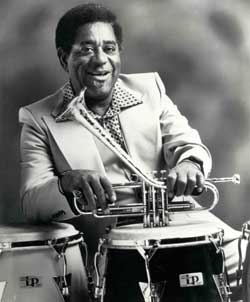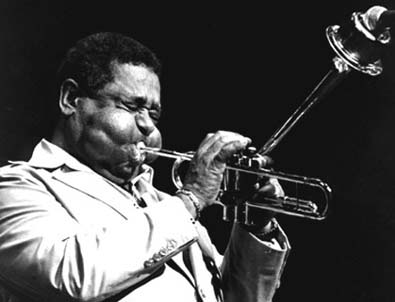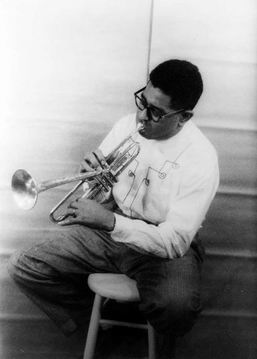
Dizzy Gillespie
- Подробности
John Birks "Dizzy" Gillespie (October 21, 1917 – January 6, 1993) was an American jazz trumpeter, bandleader, singer, and composer. He was born in Cheraw, South Carolina. Together with Charlie Parker, he was a major figure in the development of bebop and modern jazz.
In addition to featuring in these epochal moments in jazz, he was instrumental in founding Afro-Cuban jazz, the modern jazz version of the "Spanish Tinge". Gillespie was a trumpet virtuoso and gifted improviser, building on the virtuoso style of Roy Eldridge but adding layers of harmonic complexity previously unknown in jazz. In addition to his instrumental skills, Dizzy's beret and horn-rimmed spectacles, his scat singing, his bent horn, pouched cheeks and his light-hearted personality were essential in popularizing bebop, which was originally regarded as threatening and frightening music by many listeners raised on older styles of jazz. He had an enormous impact on virtually every subsequent trumpeter, both by the example of his playing and as a mentor to younger musicians.
He also used a trumpet whose bell was bent at a 45 degree angle rather than a traditional straight trumpet. This was originally the result of accidental damage caused during a job on January 6, 1953, but the constriction caused by the bending altered the tone of the instrument, and Gillespie liked the effect.
Biography
Early life and career
Gillespie was the youngest of nine children. His father died when Gillespie was ten. Dizzy drew his inspiration from his father, who played all of his favorite instruments. Gillespie taught himself to play the trumpet at the age of 12 and managed to win a scholarship to the Laurinburg Institute in North Carolina. However, he dropped out of school in 1935, moved to Philadelphia, Pennsylvania, and became desperate to work as a full-time musician. Gillespie first joined Frankie Fairfax, and made his recording debut in 1937 while filling for Roy Eldridge in Teddy Hill's band.
After finding work with Cab Calloway's group, Dizzy was soon being excoriated for his adventurous solos by his employer, who branded it "Chinese music." He lost the spot in Calloway's band for an unrelated reason, however: Calloway accused Gillespie of firing a spitball at him during a concert, and the hot-headed Gillespie stabbed Calloway in the leg with a small knife. Gillespie went through many bands including Duke Ellington's, and also arranged music for Woody Herman.
The legendary big band of Billy Eckstine gave his unusual harmonies a better setting, and it was as a member of Eckstine's band that he was reunited with Parker, after earlier being members of Earl Hines's more conventional band.
The rise of bebop
With Charlie Parker, Gillespie jammed at famous jazz clubs like Minton's Playhouse and Monroe's Uptown House, where the first seeds of bebop were planted. Gillespie's compositions like "Groovin' High", "Woody n' You", "Salt Peanuts", and "A Night In Tunisia" sounded radically different, harmonically and rhythmically, than the Swing music popular at the time. One of their first (and greatest) small-group performances together was only issued in 2005: a concert in New York's Town Hall on June 22, 1945. Gillespie taught many of the young musicians on 52nd Street, like Miles Davis and Max Roach, about the new style of jazz. After a lengthy gig at Billy Berg's club in Los Angeles, though, which left most of those in the audience ambivalent or hostile towards the new music, the band broke up. Unlike Parker, who was content to play in small groups and be an occasional featured soloist in big bands, Gillespie aimed to lead a big band himself; his first attempt to do this came in 1945, but it did not prove a success.
After his work with Parker, Gillespie led other small combos (including ones with Milt Jackson, John Coltrane , Lalo Schifrin) and finally put together his first successful big band. He also appeared frequently as a soloist with Norman Granz's Jazz at the Philharmonic.
On March 11, 1952 Gillespie left for France after being invited by Charles Delaunay to play on Salon du Jazz. Gillespie did not have any other commitments during his time in Paris and therefore embarked on his Blue Star sessions and started to assemble his third big band. Due to his prior success he could now record in the finest studios like Theatre des Champs-Elysees. In 1953 he returned to the United States after a series of successful concerts and recordings, but most importantly he proved himself to be a successful bandleader. In 1956 he organized a band to go on a State Department tour of the Middle East and earned the nickname "the Ambassador of Jazz".
Afro-Cuban music
In the late 1940s, Gillespie was also involved in the movement called Afro-Cuban music, bringing Latin and African elements to greater prominence in jazz and even pop music, particularly salsa. Gillespie's most famous contributions to Afro-Cuban music are the compositions "Manteca" and "Tin Tin Deo"; he was responsible for commissioning George Russell's "Cubano Be, Cubano Bop", which featured the great but ill-fated Cuban conga player, Chano Pozo. In 1977, Gillespie discovered Arturo Sandoval while researching music during a tour of Cuba.
Later years and death
Unlike his contemporary Miles Davis, Gillespie essentially remained true to the bebop style for the rest of his career.
In 1964 the artist put himself forward as a presidential candidate. He promised that if he were elected, the White House would be renamed "The Blues House," Ray Charles would be appointed Librarian of Congress, Miles Davis would become the head of the CIA, and Malcolm X the Attorney General. He also said his running mate would be Phyllis Diller.
Gillespie published his autobiography, To Be or not to Bop in 1979.
In the 1980s, Dizzy Gillespie led the United Nations Orchestra. For three years Flora Purim toured with the Orchestra and she credits Gillespie with evolving her understanding of jazz after being in the field for over two decades. David Sanchez also toured with the group and was also greatly affected by Gillespie. Both artists later were nominated for Grammy awards. Gillespie also had a guest appearance on The Cosby Show as well as Sesame Street.
In 1982, Dizzy Gillespie had a cameo on Stevie Wonder's hit Do I Do. Gillespie's tone gradually faded in the last years in life, and his performances often focused more on his proteges such as Arturo Sandoval and Jon Faddis; his good-humoured comedic routines became more and more a part of his live act.
November 26, 1992 at Carnegie Hall in New York, following the Second Baha'i World Congress was Dizzy's 75th birthday concert and his offering to the celebration of the centenary of the passing of Baha'u'llah. Gillespie was to appear at Carnegie Hall for the 33rd time. The line-up included: Jon Faddis, Marvin "Doc" Holladay, James Moody, Paquito D'Rivera, and the Mike Longo Trio with Ben Brown on bass and Mickey Roker on drums. But Gillespie didn't make it because he was in bed suffering from cancer of the pancreas. "But the musicians played their hearts out for him, no doubt suspecting that he would not play again. Each musician gave tribute to their friend, this great soul and innovator in the world of jazz."
Gillespie also starred in a film called "The Winter in Lisbon" released in 2004. He has a star on the Hollywood Walk of Fame at 7057 Hollywood Boulevard in the Hollywood section of the City of Los Angeles. He is honored by the Dec 31, 2006 - A Jazz New Year's Eve: Freddy Cole & the Dizzy Gillespie All-Star Big Band at The John F. Kennedy Center for the Performing Arts.
He died of pancreatic cancer in 1993, aged 75, and was buried in the Flushing Cemetery, Queens, New York. Mike Longo delivered a eulogy at his funeral. He was also with Gillespie on the night he died.
At the time of his death, Dizzy was survived by his widow, Lorraine Willis Gillespie; a daughter, jazz singer Jeanie Bryson; and a grandson, Radji Birks Bryson-Barrett. Gillespie had two funerals. One was a Baha?i funeral at his request, at which his closest friends and colleagues attended. The second was at the Cathedral of St. John the Divine in New York open to the public.
Dizzy Gillespie, a Baha'i since 1970, was one of the most famous adherents of the Baha'i Faith which helped him make sense of his position in a succession of trumpeters as well as turning his life from knife-carrying roughneck to global citizen, and from alcohol to soul force, in the words of author Nat Hentoff, who knew Gillespie for forty years. He is often called the Baha'i Jazz Ambassador. He is honored with weekly jazz sessions at the New York Baha'i Center.
Selected discography
* 1950 - Dizzy Gillespie, Charlie Parker, Thelonious Monk - Bird & Diz
* 1952 – Dizzy Gillespie. "Dee Gee Days - The Savoy Sessions"
* 1953 – Dizzy Gillespie, Charles Mingus, Charlie Parker, Max Roach, Bud Powell – Jazz At Massey Hall
* 1953 - Dizzy Gillespie, Stan Getz, Oscar Peterson, Ray Brown, Max Roach, Herb Ellis - "Diz & Getz"
* 1954 - Dizzy Gillespie. "Afro"
* 1957 - Dizzy Gillespie, Stan Getz, Coleman Hawkins - "Sittin' In"
* 1957 - Dizzy Gillespie - "At Newport"
* 1957 - Dizzy Gillespie, Sonny Rollins, Sonny Stitt - "Sonny Side Up"
* 1959 - Dizzy Gillespie - "Have Trumpet, Will Excite"
* 1961 - Dizzy Gillespie - "An Electrifying Evening with the Dizzy Gillespie Quintet"
* 1964 - Dizzy Gillespie, James Moody, Kenny Barron - "Jambo Caribe"
* 1967 - Dizzy Gillespie - "Swing Low, Sweet Cadillac"
* 1977 - Dizzy Gillespie, Count Basie - The Gifted Ones
* 1985 – Dizzy Gillespie, Robert Ameen, Branford Marsalis, Kenny Kirkland, Lonnie Plaxido – New Faces
* 1989 – Dizzy Gillespie and the United Nation Orchestra – Live at the Royal Festival Hall London July 10, 1989
* 2000 – Dizzy Gillespie – Ken Burns Jazz
Main menu
Anthology
Sheet Music Archive
 lesson 1lesson 2lesson 3
lesson 1lesson 2lesson 3

